Purple Plants
Purple can be a calming, inspiring, and even regal color addition to any landscape. You can find a range of purples in flowers, foliage plants, and even vegetables.
Flowering Plants

Breeders have developed cultivars of purple coneflower that aren’t purple, but many gardeners choose the native species in order to attract and feed butterflies.

Pickerel weed is a native aquatic plant that can be found throughout Florida. Beyond its visual allure, it serves an important ecological purpose as habitat for the invertebrates that a food source for fish, amphibians, ducks, and reptiles. The flowers attract butterflies and the seeds are a tasty treat for ducks, making this plant a water garden winner.
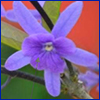
Queen’s wreath is a tropical vine that resembles wisteria. The flowers are densely packed in a form that, from a distance, resembles a bunch of grapes. The actual flowers are small and light blue or purplish. They will eventually fall, leaving the calyces. A calyx is the base of a flower and is usually green, but queen’s wreath boasts purple calyces as attractive as the true flower petals.
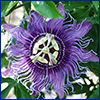
As the host plant for the Gulf Fritillary butterfly, passion flower is a popular native vine for butterfly gardens. Grow yours on a fence, trellis, or arbor in a sunny spot. It often spreads beyond its original planting spot, so be sure to give it room to roam.
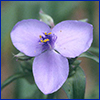
Spiderwort is considered a weed by some and a cheerful wildflower by others. This perennial is native to Florida, blooming in spring with one-inch flowers that have three petals and come in either white, pink, blue, or violet. Each flower lasts less than a day, but the plants put out new flowers for six to eight weeks.

Stokes’ aster is a showy native perennial that can make a wonderful addition to your landscape. Growing best in zones 8 through 9A, these versatile flowers work wonderfully in borders, containers, or as part of a butterfly garden. When used as cut flowers, Stoke’ aster will hold up for about a week after cutting.
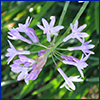
Society garlic is a groundcover that produces star-shaped purple flowers. The rhizomes and leaves are edible, as well as the flowers, which can be used as a delicate garnish.
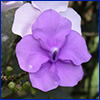
Yesterday, today, and tomorrow has particularly interesting flowers that start out purple and fade to white over a day or two. It isn’t widely available in nurseries, so you may want to ask a friend who’s already growing it to start a cutting for you.

Chastetree is a flowering shrub or small tree that produces clusters of purple flower spikes from late spring to fall. Butterflies feed on the nectar in its flowers, and small birds enjoy eating its seeds.

Agapanthus is a summer-flowering bulb that generally produces purple or white flowers in clusters atop a tall spike. Some varieties can be blue in color. Their pom-pom shaped flower clusters attract hummingbirds and work well as cut flowers.
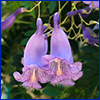
Jacaranda is one of the botanical treasures of Central and South Florida. It grows as a delicate, deciduous, spreading tree. Its fern-like foliage provides light, dappled shade, perfect for patios. The trumpet-shaped flowers emerge in clusters of lavender, violet, purple, or white.
Foliage and Berries
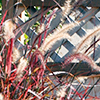
Purple fountain grass can add a splash of burgundy-purple ornamental grass to your landscape. The flower plumes dry well and can be used in floral arrangements, making it a unique choice for a cutting garden.

Persian shield is perfect for providing some true, vibrant purple foliage to your landscape. This large, shade-loving perennial has irridescent purple leaves that shimmer with a hint of silver. Adding interest, the leaves also feature bold green stripes along the veins.
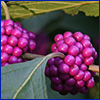
Beautyberry is dazzling in your landscape and much loved by birds. This Florida native is scientifically known as Callicarpa americana, and its bright purple berries are some of the most striking around.
Vegetables

Some varieties of leafy greens can actually provide your landscape with some tasty and eye-catching leafy purples. Red cabbages like ‘Salad Delight’, ‘Omero’, ‘Deadon’, and ‘Red Express’ yield lovely red to purple heads of cabbage. Ornamental varieties of kale (pictured) like ‘Nagoya Rose’ or ‘Redbor’ offer up a little something different; plus, you can use them to spruce up a salad or make crunchy kale chips. Rounding out the leafy reddish-purple vegetables is Japanese giant red mustard. With maroon and chartreuse leaves, plus a spicy kick, this mustard variety could make for a tasty change in your favorite greens recipe.
